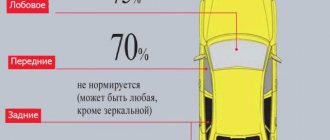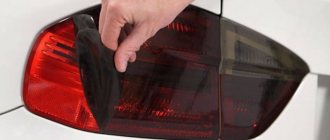Types of tinting
Films for tinting car windows differ in quality, shades and degree of light transmittance.
Darkening materials are divided into several types:
- factory tinted windows;
- glass tinting varnish;
- film with an adhesive layer and a darkening effect;
- curtains
You can make windows darker using any of the following methods. Film and varnish produced by different manufacturers differ in quality, so it is better to use well-known materials.
What tint should you use:
- 3M;
- Llumar;
- SunTek;
- SunControl;
- Armolan;
- Global;
- MTF.
When covering glass with cheap tinting, after some time cloudy inclusions, streaks and fading may appear. The choice of color depends on the personal wishes of the driver and the shade of the car body.
Applying film for tinting on car side windows
Wet the surface of the side glass and use a scraper to clean its lower part. Then lower the glass a few centimeters, wet it and also clean the rest of the surface using a scraper.
Clean the surface with the blade consistently and make sure that there are no uncleaned areas.
Next, wash the glass with a hard sponge and wipe dry using a rubber pad. Wipe the edges of the glass with a napkin. Moisten and wipe the glass again with a rubber pad.
- Before applying the tinting film, wet the glass generously.
- Then it is necessary to remove two-thirds of the liner protecting the adhesive layer from the workpiece and moisten the adhesive surface. It is convenient to carry out this operation on the rear window of the car by placing the pattern with the adhesive layer facing outwards.
- It is better to cut off the excess liner removed from the workpiece before applying the tint film.
Wet your fingers. Your fingertips must be clean, since in the process of tinting the glass you will need to touch the adhesive layer of the film.
Carefully take the workpiece and place it on the prepared glass surface.
Try to ensure that the adhesive layer only touches the surface of the glass and does not touch the seals or other surfaces.
Align the tint film along the top edge. Make sure that there are no gaps or gaps anywhere, and begin to carefully squeeze the solution out from under it.
Follow a few simple rules:
- Hold the pattern with your hand, since when you initially squeeze out the liquid, the workpiece will slide along the glass.
- Squeeze water from the center to the edges.
- Use rubber and then hard forcing. Using hard distillation, expel the liquid in the same directions - from the middle to the edges.
- Then, using a forcing tool and a hair dryer, fix the film at the top edge of the glass.
- After this, use a knife to remove the excess tinting film protruding onto the upper edge of the glass - this technology allows you to avoid leaving gaps along the upper edge.
Raise the glass. Bend down the bottom part of the pattern protected by the liner and generously moisten the glass with the solution. Remove the liner completely.
Do this extremely carefully and make sure that the film without a liner does not touch anything other than the glass with its adhesive layer!
Carefully tuck the tint film under the glass seal. Squeeze out the horizontal inner seal using a force and, when inserting the film for tinting, make sure that it does not break - this operation also requires certain skills, so be especially careful (pay attention to how the master will carry out this operation in the video tutorial below) .
- Squeeze the solution out from under the film using hard forcing: squeeze out the water in successive movements from top to bottom and from the middle to the edges.
- Finally remove any remaining moisture using a distiller wrapped in a napkin and a hairdryer.
- Make sure that no water bubbles remain under the film during the tinting process.
The technology for cleaning and sticking small fixed glasses will be identical.
Materials and tools
Car window tinting is a simple process that you can do yourself. However, to achieve a good result, you need to be careful and use quality materials.
Film tinting tools:
- industrial dryer;
- lighting equipment or bright lamp;
- sharp stationery knife;
- rubber spatula for smoothing tint on glass;
- a set of soft microfiber cloths;
- soap solution for tinting;
- spray with air pumping for uniform spraying of the composition.
When varnishing, you need to dismantle the part or carefully close the interior trim using rags, newspapers and masking tape. A degreasing mixture used to treat the surface before painting can harm door cards, so they must be protected with a thick cloth.
To install tinted curtains or finished glass at home you will need:
- screwdrivers;
- spanners.
All necessary clips and hooks for curtains are secured in hidden places using the included latches and screws.
When tinting car windows yourself, you should be careful not to let the liquid get into your eyes.
Preparation and tools to tint your car
We've sorted out the laws, chosen the film, and now we can get to work. You immediately need to choose a suitable place for the upcoming manipulations. The street is not very suitable for this. Dust, insects, wind and direct sunlight are the main list of unacceptable conditions. A spacious garage or box is ideal.
This is interesting: From history
To ensure that the execution process does not stop “at the most interesting place,” prepare all the tools and materials in advance. You will need:
- The tint film itself is in the required quantity. Decide how many glasses you will tint and calculate the area. Allow a margin of 10–20% for adjustment.
- Water spray in any form. Needed for spraying soap solution.
- Liquid soap or Fairy, clean water.
- Something sharp and cutting: an ordinary blade, a stationery knife, a scalpel.
- Lint-free wipes.
- Forcing is a special spatula with which you will remove the solution from under the film. Should be firm, but without sharp edges. They are usually plastic and some manufacturers include them with film. If you are unlucky, then look for them in construction or automotive stores; they are also definitely available in stores for outdoor advertising specialists.
- Special scraper for cleaning windows (optional, greatly facilitates the cleaning process).
- Electric hair dryer with temperature controller (we need 550 degrees Celsius).
Everything you need to do it yourself (photo)
Spray gun Fairy Construction hairdryer Scraper for cleaning windows Film Stationery knife Forcing Lint-free napkins
Car preparation
To perform high-quality car window tinting, you need to prepare the materials and the car in advance. A properly cleaned window will provide good visibility at any time of the day and will not become stained when pasted.
High-quality tinting is covered with a protective layer that can withstand small mechanical loads. However, a grain of sand that gets on the glass can break through the film when smoothing it with a scraper during the pasting process.
Preparing for tinting at home:
- Wash the car body thoroughly with a high pressure washer.
- Apply a soap solution to the inside of the windows and use a blade to go over the entire surface to cut off any adhered grains of sand and dirt deposits.
- Remove the decorative trim from the posts.
- Thoroughly rinse the corners and hidden cavities of the front and rear shields.
- Degrease the prepared surface.
The heated rear window should not be treated with a blade or cleaned with a hard sponge. If dirt is found, it should be washed off with window cleaning chemicals until it disappears completely.
After cleaning the windows, you need to make a pattern from the film or cover the interior panels for painting with varnish.
All work is carried out in a room with a positive air temperature. Before tinting, you can wet the floor with a spray bottle to prevent dust from being raised when walking.
We begin to glue the tint film on the car
Car owners who have never done tinting before are often interested in: how to apply tinting - from the outside or from the inside? The answer is clear - it is more practical and functional to do it from the inside. Although preparatory work, such as pattern making or heat molding, can be done outside.
It is generally advisable to dismantle the glass, if possible, then the work can be done in a dust-free room, and it will be done more accurately, since you can quickly and conveniently get rid of “bubbles.” But in general this is not necessary.
In any option (with or without glass dismantling), work begins with degreasing the surface with a solvent. Be sure to remove the glue from the previous tint using a utility knife. The cleaned surface should be washed with soapy water and the glass should be wiped with a dry cloth or sponge. It should be smooth and clean.
How to darken a rear window
The tinting of the rear windows is no different from the windshields. To give a unique shape, a template is made and glued to a pre-treated surface.
Shields with heating threads should be passed with a scraper in a horizontal plane. This will protect the chain from damage and ensure a better fit of the tint. When carrying out work, you need to disconnect the plug going to the thread, and also remove the additional brake light.
Film template
Tinting the rear window begins with preparing a template. To do this you need:
- Cut material to fit.
- Apply to damp glass and smooth with a scraper.
- The corners are heated with a hairdryer and take the exact shape.
When making a template, it is important to lay the material with the adhesive layer facing up, otherwise, when gluing it to the inner surface, the corners will be bent in the other direction.
How to apply tint
Tinting the rear window is done using a squeegee, soap and water, or window cleaner. To protect the shelf from getting wet, you can cover it with a cloth.
Gluing tint to the rear window:
- Degrease the inside and wipe with a clean cloth.
- Inspect the surface for the presence of villi, hairs, and grains of sand.
- Treat the window with liquid.
- Tear off the transparent layer and apply the material to the glass.
- Wet the surface generously.
- Move the material in the desired direction, clearly matching the boundaries.
- Carefully remove the water using a rubber scraper.
Pasting is carried out without a hairdryer, since the template follows all the curves of the shield. After drying, you can install the brake light and return the plastic panels to their place.
Making a pattern
Regardless of which glass on your car you are going to tint with a special film, for high-quality work you need to make an accurate pattern.
Proper tinting of a car with your own hands involves preparing the product for subsequent gluing to the surface. To do this, follow several rules and perform sequential actions:
- First, find the layer where the glue is located. To do this, simply pay attention to where the clear protective layer is.
- The material should only be cut along the roll being used.
- Be sure to leave a small allowance so you can adjust the material to size later. The allowance, depending on the glass, is a few centimeters or millimeters.
- Moisten the glass and cut a piece of the required size from the total roll.
- Place the piece on the glass, turning the protective layer towards you.
- Start aligning the bottom edge so that it is parallel to the bottom seal on the glass.
- An allowance of about 1-2 cm is made for the workpiece.
- Now a vertical cut is made on the pattern in several sections to obtain an overlap on the vertically located edging of the car door.
- The completed procedures will allow you to bend the lower part of the workpiece and secure it to the edge.
- The film is fixed along the edge of the window, after which horizontal cuts are made to create the finished shape of the workpiece.
If you are tinting windows that do not roll down, it is enough to make an allowance of a few millimeters. All other procedures for making the workpiece are similar.
Cuts should be made with extreme care using a sharp knife or suitable scissors. Be careful not to damage the glass edge. To do this, it is convenient to use a forcing device, which is placed close to the seal.
The pattern procedure for the rear window of a car is somewhat different. The dry method is used here, that is, the film and glass must remain dry.
- Using a wet sponge, apply the letter H to the surface of the glass.
- The film is laid along the roll, and the adhesive layer should face outward.
- A small allowance is made to completely cover the car glass. Please note that the rear glass has a certain sphericity, so be careful when choosing the size of the allowance.
- The excess is cut off with a sharp knife. This is where you really need the help of a partner.
- The film is leveled so that horizontal folds do not form. The technology allows for vertical folds.
- Smoothing is performed with careful vertical and horizontal movements, parallel to the effect of a hairdryer on the glass.
- Using a hair dryer, carefully adjust the temperature. The rear window cannot be overheated, as it does not like sudden temperature changes.
- Heating smooths out only vertical folds.
- After removing the wrinkles, apply a soap solution.
- The surface is smoothed out again. If everything is done correctly, the film will lie perfectly evenly and accurately follow the contours of the glass.
- Smoothing should be done using movements from the center to the edges. It's better to use forcing. Creases are not allowed.
- At the last stage of pattern making, the edges should be trimmed as accurately as possible.
Not everything always works out perfectly the first time. Therefore, experienced motorists advise beginners to practice first. To do this, you can use cheap film and some unnecessary car glass. Or take one side glass as a basis and practice the technique on it.
Just before finishing work, do not forget to thoroughly clean the surface from possible traces of glue.
Working with side windows
If you have successfully completed the pattern making, you can begin the finishing processes. First you need to figure out how to properly glue removable tint. Here again you will need the help of a friend, although some motorists can successfully cope on their own.
This is not to say that the technology of sticking a special removable tint film onto glass is overly complicated. Yes, there are some nuances here, but with the right approach, in most cases, car enthusiasts cope with the task.
Work carefully and consistently, without violating the basic recommendations.
- Prepare the glass. At this stage, it is necessary to remove any remaining contaminants. For such work you will need a scraper and a sufficiently large amount of soap solution. Don't skimp on the liquid, as it only requires a few drops of shampoo and regular tap water to prepare it.
- Raise and lower the glass completely if it is movable. This will remove dirt from all areas.
- After cleaning with a scraper, take a hard sponge and scrub the glass with soapy water. To remove any remaining solution, use a distiller and paper napkins. Now wet the surface again and go over the entire glass with a rubber pad. Such procedures will help ensure maximum adhesion of the film and glass, so preparation should not be ignored.
- Before applying the film, the glass is again wetted with a soap solution. As you can see, you will have to cook a fairly large amount of water.
- Pasting begins from the top of the glass, which needs to be lowered literally 2-3 centimeters.
- Approximately 60% of the protective layer needs to be removed from the pattern. The adhesive surface must be moistened with soapy water. It is better to immediately cut off the excess protective layer, otherwise it will interfere with you when applied to the glass.
- After wetting the glass and film, be sure to also wet your hands, having washed them first. Otherwise, with dry hands you will come into contact with the adhesive on the tint, which will lead to reduced adhesion and the appearance of fingerprints between the glass and the film. It will be difficult to remove them later.
- The prepared pattern is carefully applied to the glass. Make sure that the film with its adhesive layer does not touch the seals or other parts of the car.
- Alignment is performed along the top edge of the glass. Check if there are any gaps anywhere. If you apply it evenly, you can remove excess moisture.
- At first, the film may slide on the glass, which is due to the large amount of water. It's not scary. Try to support the material with your hand.
- Using forcing, remove moisture using movements from the center to the edges. First, take a soft tool, and then you can move on to hard forcing.
- A hard tool should be used to remove moisture in the same way as a soft one. That is, movements are performed from the center of the glass to the edges.
- Using a hairdryer and forcing, the pattern is fixed along the top edge. Since the workpiece was made with a reserve, the excess is then carefully cut out. Due to this, tinting is performed without gaps.
- When the top part is finished, the glass can be lifted and tinting can continue in the lower section. The glass and film are wetted again with water, and the protective layer is completely removed. The film should be tucked under the seal. It can be slightly bent by forcing. Be careful not to make creases in the tint.
- Remaining moisture is removed from under the pattern. If there are no air bubbles or water droplets under the film, the job is done perfectly.
By analogy, blind windows that do not go down are glued. Only the overlap here needs to be made somewhat smaller so that you don’t have to cut out a large amount of excess later.
Rear window
When planning to tint the rear windows of a car with your own hands, pay special attention to the presence of special threads that are responsible for heating. If they are present, you will have to abandon the scraper. Instead, use plastic spatulas for cleaning.
Do-it-yourself rear window tinting itself is not much different from tinting the side windows. The procedure is similar, although it has some features.
- Before applying tint to your rear window, first apply some soapy water. After treating the surface with a spatula, take a hard sponge, wipe off the remaining liquid with paper napkins, and perform the final cleaning using distillation.
- Now the glass can be generously moistened again in a solution of car shampoo and regular tap water.
- Gradually remove part of the protective layer and add the solution to the adhesive surface.
- Now the pattern needs to be placed above the rear window. There is a possibility that the film will begin to curl. This is normal, so it is better to ask a friend to help you in advance. This will prevent the appearance of creases.
- Align the workpiece with the surface of the glass, check if there are any gaps anywhere.
- Smoothing begins from the center to the edges using rubber pressing.
- If in some areas the rubber forcing does not allow you to level the film, take a plastic spatula.
- Moisten the surface with the solution again, then remove any remaining air and moisture using the same distillation. Just before doing this, it is recommended to wrap the instrument in a napkin.
- Be extremely careful when removing water from the area where the threads are located. Do not damage them, otherwise there is a risk of disrupting the heated rear window.
- At the last stage, press the material along the entire perimeter, heating the edges with a hairdryer. It is strictly forbidden to overheat the glass, so carefully monitor the temperature.
As you can clearly see, there is nothing particularly complicated about tinting rear car windows. The main distinguishing feature is the presence of heating threads. You should be as careful as possible with them. Otherwise, this is the same consistent and accurate procedure.
How to remove tint
Tinted windows become scratched and scuffed over time. In this case, you will need to remove the old film and apply a new one.
To delete, you can use the following methods:
- heat;
- soapy water;
- special chemical compounds.
Heat removal uses a hair dryer to melt the adhesive. When the film is removed, the glass remains clean and does not require additional processing.
When the adhesive layer is softened with soap, streaks and cloudy marks remain, which can be easily removed with a degreaser and a razor. When working with caustic agents, cover the panels with cloth or newspapers.
When cleaning the rear shield from glue, be careful not to damage the heating filaments. If the fiber breaks, it will require restoration by service or using conductive glue.
Tools and materials for creating and gluing film
You can make tinting for car windows yourself using special consumables. To create, you will need a sheet of polyester (PET) no more than 0.5 mm thick and a film that will be applied to the plastic. The following set of tools is also required:
- knife with replaceable blades;
- pencil for drawing outlines;
- metal scissors;
- forcing to smooth out irregularities on the film;
- a spray bottle for applying a soap solution to the surface of the glass.
The forcing can be purchased at a construction supply or outdoor advertising store.
In addition to tools and materials, it is necessary to first prepare a cleaned and smooth surface on which the film will be applied to the plastic. For this purpose, you can use glass with a thickness of 15 mm or more.
Adviсe
Tinting without removing the windows does not take much time. To achieve a good result and tint the car without flaws, you need to carefully inspect the shield for dirt and foreign objects.
Windshield tinting is the most difficult step due to the curves and large area. Difficulties are often caused by cutting space for mirrors and rain sensors. For convenience, you should guide the knife along the black line of the silk-screen printing and do not step beyond it.
When selecting material to match the body color, you should avoid bright red shades, which change the correct perception of colors and can confuse the driver while driving.
If certain specifications of the adhesive are observed and high-quality materials are used, the car windows will noticeably transform and retain light transmittance. When caring for tinting, do not use aggressive products or rags with hard bristles: this can lead to clouding and scratches.
How to properly apply tint film
First, thoroughly moisten the inside of the glass with soapy water. Then remove the liner (protective layer) from the cut pieces. To do this, look for delamination on the edges of the material and carefully pull the edge of the backing.
The tint should not bend. It can be difficult to apply the tint film yourself at this stage, so it is useful to enlist the help of a friend. While one person removes the liner, another thoroughly wets the adhesive side with soapy water.
Once the tint is peeled off from the backing, it's time to attach it to the glass. The soap solution neutralizes the glue for a while so that you can position the material exactly in place. Once the film is adhered, use a putty knife to get rid of any bubbles. Use it to iron the tint coating from the center to the edge. Wipe the glass with a soft cloth or sponge and leave to dry.
If you did not perform heat molding (for example, on side flat glass), dry the film with an industrial hair dryer and, after drying, trim the edges to the shape of the glass.
Now you know how to glue tint film to glass with your own hands. The complete process of pasting all the glass takes several hours, but you save on car service costs.
How to tint a car's rear window
It is not uncommon to see tinted windows with the film peeling off, or air bubbles visible on the car glass. All defects occur due to the fact that when applying the film material the surface was poorly washed, and when installing the TP, water and air were not sufficiently expelled from under it.
Before tinting the rear window (RW), it must be washed very well, not only from the outside, but also from the inside.
Next we perform tinting in the following order:
- apply a 1.5 m wide film to the rear window, cut off the TP along the contour with a small margin;
- heating with a hairdryer, straighten the film with a spatula, straightening it from the middle to the edges;
- the film should be heated carefully; if overheated, it may become deformed, which will lead to damage to the material;
- using the lighting inside the cabin, we cut out the formed TP along the contour, the size of the workpiece should be approximately 2 mm larger around the perimeter of the white glass, that is, slightly overlap the black edging;
- Before gluing the film material, thoroughly wash the glass from the inside. Each speck of dust remaining on the surface of the surface forms an air bubble;
- wash off the soap suds with a stream of water under pressure;
- We remove the protective layer from the film, while simultaneously wetting the TP with a soap solution. The tint film has two sides - lavsan and tinting (adhesive), so when installing the sides you need to not mix up the sides and install the tint material correctly;
- open the door, place the film in your place, you need to do this together. The TP should be applied smoothly, without sudden movements - you should not touch the adhesive side, nor create dust with your movements. It should be noted that it is more difficult to install the film in a sedan than in a hatchback;
- Having fixed the tinting material on the glass surface, we begin to carefully straighten and smooth it with a spatula, expel air and water from under the film with movements from the center to the edges of the surface;
- Use a rubber spatula to squeeze out the remaining water between the surface and the film;
- to smooth the TP along the edges of the glass in a sedan, we use a forcing tool (trowel) with a long handle, since getting to the edges here is not easy;
- To speed up the drying process of the glue, warm up the surface using a hairdryer.
Despite the apparent simplicity of the work, it is very difficult to properly lay the film on the rear window, and tinting may not work the first time. The most important thing in this matter is to take your time and do everything strictly according to the instructions.










